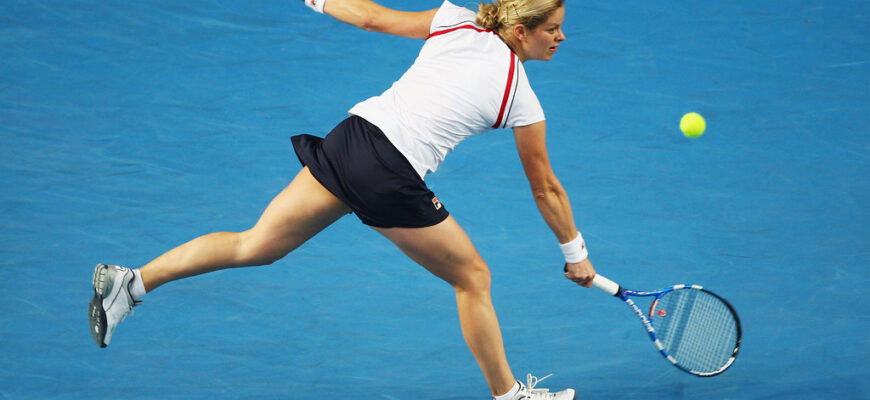In the high-stakes world of professional tennis, where narratives often swing between triumphs and tribulations, the voice of a seasoned champion offers a rare blend of insight and realism. Kim Clijsters, a four-time Grand Slam winner and former world No. 1, recently provided a candid glimpse into her world, touching upon emerging talents, the rigorous demands of coaching, her legendary comeback as a mother, and the perennial debates that echo through the women’s tour.
Nurturing the Next Generation: A Keen Eye for Talent
Clijsters, whose academy now cultivates aspiring tennis stars, admits to keeping a close watch on one particular prodigy: Yelin Vandromme. At just 17 years old, Vandromme has already made waves, claiming the Junior US Open title and currently holding the 505th spot in the world rankings. Her connection to Clijsters’ academy runs deep, having been observed since childhood. “I`ve known her since she was six or seven,” Clijsters revealed, highlighting the long-term investment in developing genuine talent. It`s a testament to the belief that true potential isn`t just spotted; it`s nurtured from its very roots.
The Coaching Conundrum: More Than Just a Call Away
The allure of coaching top-tier players is undoubtedly strong, and Clijsters herself has received intriguing propositions. However, her stance on the matter is unequivocally clear: it`s a commitment she`s not yet prepared to make. The primary hurdle? Travel. Clijsters emphasizes that effective coaching demands significant personal involvement—a minimum of 15-20 weeks a year dedicated to direct interaction. She believes a truly good coach needs to be more than just a voice on the other end of a phone line.
“I consider that to be a good coach, you have to spend a minimum of 15-20 weeks a year with the player. I don`t want to be a coach who is just on the phone. I believe you need personal contact, communication, understanding of the player.”
Her family life, with a youngest child yet to turn nine, also plays a pivotal role in her decision. The desire to be present at home outweighs the temptation of returning to the relentless tour schedule, even for a role as influential as coaching. A pragmatic choice, perhaps, but one that underscores her deep commitment to both her passion and her family.
The Remarkable Comeback: A Mother`s Drive, Not a Secret Formula
Clijsters` return to professional tennis after becoming a mother, winning three more Grand Slams, remains one of the sport`s most inspirational stories. Yet, she insists there was no grand secret, no revolutionary training regimen. Her “secret” was simply returning to consistent training with her trusted coach, Sam.
Her initial retirement, she explains, was born from a genuine disillusionment with the “circus” surrounding the sport, not the game itself. A serendipitous invitation to a Wimbledon exhibition match, following a personal tragedy, reignited a competitive fire. Not against others, but a deeply personal desire to challenge herself.
The most profound change post-comeback, however, wasn`t tactical but temporal. Traveling with her daughter transformed how she viewed her time on tour. What was once “free time” for movies or relaxation became precious moments shared, an “extraordinary adventure” that added a new dimension to her demanding career. It appears motherhood didn`t just enhance her life; it optimized her schedule, forcing a level of efficiency many can only dream of.
The Unchanging Calendar: A Perpetual Tennis Debate
One aspect of the WTA tour that appears as constant as the bounce of a tennis ball is the player complaints regarding the calendar. Clijsters, having served on the WTA board from 2003-2004, confirms that these grievances are nothing new. “Complaints about the calendar have been, are, and always will be,” she notes with a touch of world-weary wisdom.
To truly shorten the season, a fundamental overhaul of the entire ranking and points system would be necessary, a change many players, despite their vocal dissatisfaction, are hesitant to embrace. It`s a classic Catch-22: players desire more rest but also seek more opportunities and prize money. Clijsters highlights the practical realities:
- Unequal Match Play: Not all players reach finals; many exit early, naturally allowing for rest before the next event.
- Season-End Necessity: Tournaments in November and December are crucial for players who haven`t had extensive match play throughout the season.
- Serving All Levels: The current system, while imperfect, serves a broader range of players, not just those consistently reaching the latter stages of major tournaments.
Her conclusion is a stoic acceptance: the long calendar is simply part of the sport, and embracing that reality is key. It`s a system designed to accommodate a diverse talent pool, ensuring that even those who don`t consistently grace the main stages still have a livelihood.
Kim Clijsters, through her reflections, offers more than just anecdotes; she provides a valuable perspective on the intricate ecosystem of professional tennis. Her insights, delivered with characteristic frankness, serve as a reminder that behind the fierce competition and gleaming trophies, the sport is a complex interplay of personal ambition, family values, and unwavering pragmatism.








